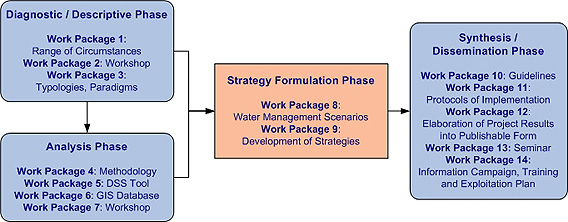
ISSUE 1 |
||
| ||
About the Project | ||
|
The project aims to contribute to solving problems of water shortage in arid and semi-arid regions of Southern Europe, where conditions and issues are different to those in the Northern Europe. The decline of water resources, in combination with increasing demand for freshwater, causes conflicts between competing users, even in comparatively water rich areas. It is necessary to develop appropriate water management tools and decision-making practices, as well as well-planned interventions for increasing the availability of supply and/or managing the growing demand. |
The project seeks to develop and evaluate strategies and guidelines towards integrated water resources management in the Southern European Regions. Its implementation will have as an outcome the formulation of water management policies that will comply with some key-policies of the European Commission. Issues of importance are the:
quality of the environment and the availability of natural resources
development and
|
|
|
| ||
Water Management and Arid Regions |
Arid and semi-arid regions of Southern Europe face conditions different to those in the North; declining water resources and increasing demand for freshwater cause threats that provoke conflicts between competing and conflicting users, even in comparatively water rich areas. Appropriate water management tools and decision-making practices as well as well-planned interventions for increasing the availability of supply and/or managing the growing demand are necessary for solving the problems of water shortage. There are variations over the definition of aridity and the boundaries of arid and semi-arid regions. The terms “aridity” and “water deficiency” are not interchangeable, yet they cover a large proportion of the Mediterranean countries. In order to provide an overview of the conditions in Southern European regions, six participating countries were examined; regionalization was a key step for the selection of a representative sample of regions. |
It was important to select a suitable range of regions in terms of water deficiency, to ensure that the analysis outcomes can eventually apply to as wide a range of water deficient areas as possible, to emphasize the regionality of water shortages, and to study those particular areas by way of characteristic case studies. The regions analysed were selected based on the following criteria, or their combinations:
in the areas
permanent or seasonal basis due to natural or man-made reasons, or the recurrence of drought and/or flood cycles,
management in the areas,
institutional framework for the effective water resources management,
areas that affect the management of water resources. |
|
| ||
Project Structure |
The WSM Project is undertaken in four distinct Phases, Diagnostic / Descriptive, Analysis, Formulation of Strategies, and Synthesis / Dissemination (Figure 1). |
Phases 1 and 2 pave the road towards Strategy Formulation, the 3rd Phase of the work and central goal of the project, while Phase 4 will develop the means to disseminate the Project Results. |
 | ||
|
Figure 1. The four phases of the WSM Project | ||
|
| ||